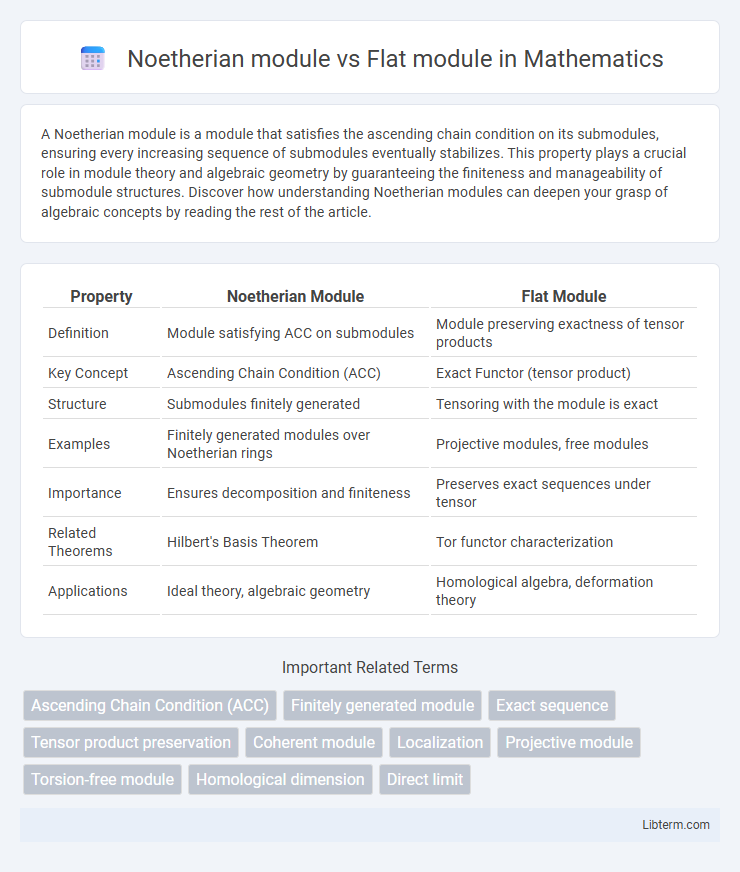A Noetherian module is a module that satisfies the ascending chain condition on its submodules, ensuring every increasing sequence of submodules eventually stabilizes. This property plays a crucial role in module theory and algebraic geometry by guaranteeing the finiteness and manageability of submodule structures. Discover how understanding Noetherian modules can deepen your grasp of algebraic concepts by reading the rest of the article.
Table of Comparison
| Property | Noetherian Module | Flat Module |
|---|---|---|
| Definition | Module satisfying ACC on submodules | Module preserving exactness of tensor products |
| Key Concept | Ascending Chain Condition (ACC) | Exact Functor (tensor product) |
| Structure | Submodules finitely generated | Tensoring with the module is exact |
| Examples | Finitely generated modules over Noetherian rings | Projective modules, free modules |
| Importance | Ensures decomposition and finiteness | Preserves exact sequences under tensor |
| Related Theorems | Hilbert's Basis Theorem | Tor functor characterization |
| Applications | Ideal theory, algebraic geometry | Homological algebra, deformation theory |
Introduction to Noetherian Modules and Flat Modules
Noetherian modules are modules over a ring characterized by the ascending chain condition on their submodules, ensuring every increasing sequence of submodules stabilizes, which implies finitely generated submodules play a crucial role in their structure. Flat modules preserve the exactness of sequences when tensoring with any module, making them essential in homological algebra and algebraic geometry for their property of not introducing torsion. Understanding the distinction between Noetherian modules, which emphasize finite generation and chain conditions, and flat modules, which focus on tensor product exactness, is pivotal in module theory and ring theory.
Defining Noetherian Modules
Noetherian modules are defined by the property that every ascending chain of submodules stabilizes, meaning there exists no infinite strictly increasing sequence of submodules. This condition ensures that every submodule is finitely generated, which is a crucial aspect distinguishing Noetherian modules in module theory. In contrast, flat modules preserve exact sequences under tensoring but do not necessarily have restrictions on their submodule chains or finite generation.
Understanding Flat Modules
Flat modules are characterized by the preservation of exact sequences under tensor products, ensuring no introduction of torsion or distortion when tensoring with any module. This property contrasts with Noetherian modules, which emphasize finite generation and the ascending chain condition on submodules, ensuring well-behaved decomposition and structure theory. Understanding flat modules requires analyzing their role in homological algebra, particularly as they guarantee the exactness of tensor functors and facilitate the study of module extensions and localizations.
Key Properties of Noetherian Modules
Noetherian modules are characterized by the ascending chain condition on submodules, ensuring every increasing sequence stabilizes, which implies all submodules are finitely generated. These modules exhibit crucial properties such as submodules and quotient modules also being Noetherian, and finitely generated modules over Noetherian rings themselves being Noetherian. In contrast, flat modules preserve exact sequences under tensoring but do not necessarily satisfy finiteness conditions or chain conditions on submodules, distinguishing them fundamentally from Noetherian modules in module theory.
Essential Characteristics of Flat Modules
Flat modules preserve exact sequences under tensoring, ensuring that tensoring with a flat module is an exact functor. Unlike Noetherian modules, which satisfy the ascending chain condition on submodules, flat modules are primarily characterized by their ability to maintain the exactness of sequences, making them crucial in homological algebra and deformation theory. This essential property differentiates flat modules as they facilitate the study of module extensions and base change without introducing torsion or distortion.
Algebraic Differences: Noetherian vs Flat Modules
Noetherian modules are defined by the ascending chain condition on submodules, ensuring that every submodule is finitely generated, which limits complexity and facilitates classification. Flat modules are characterized by the property that tensoring preserves exact sequences, highlighting their role in maintaining exactness and preventing the introduction of torsion. The key algebraic difference lies in that Noetherian modules emphasize finiteness and structure constraints, whereas flat modules focus on homological behavior and exactness preservation under tensor products.
Examples Illustrating Noetherian and Flat Modules
Noetherian modules include finitely generated modules over Noetherian rings, such as \(\mathbb{Z}\)-modules like \(\mathbb{Z}/n\mathbb{Z}\), ensuring every ascending chain of submodules stabilizes. Flat modules, exemplified by free modules like \(\mathbb{Q}\) as a flat \(\mathbb{Z}\)-module, preserve exactness under tensor products and include projective modules. The module \(\mathbb{Z}/n\mathbb{Z}\) is Noetherian but not flat, whereas the module \(\mathbb{Z}\) is both Noetherian and flat over itself.
Interplay: When Are Noetherian Modules Flat?
Noetherian modules are flat primarily when they are projective since projectivity implies flatness and finitely generated projective modules over Noetherian rings preserve this property. The interplay hinges on the ring structure: over a Noetherian ring, all finitely generated flat modules are projective, making these modules both Noetherian and flat simultaneously. However, not all Noetherian modules are flat unless additional conditions like projectivity or torsion-freeness in combination with ring properties are met.
Applications in Commutative Algebra and Homological Algebra
Noetherian modules, characterized by their ascending chain condition on submodules, play a crucial role in commutative algebra by ensuring finiteness properties that facilitate primary decomposition and dimension theory. Flat modules, defined by their preservation of exact sequences under tensoring, are essential in homological algebra for constructing and understanding resolutions, localizations, and base change operations. The interplay between Noetherian and flat modules underpins key applications such as descent theory, cohomological dimension analysis, and the study of formal schemes.
Summary: Choosing Between Noetherian and Flat Modules
Noetherian modules are characterized by the ascending chain condition on submodules, ensuring every submodule is finitely generated, which guarantees strong finiteness properties ideal for algebraic geometry and commutative algebra. Flat modules preserve exact sequences under tensoring, making them essential for base change and deformation theory where maintaining exactness is crucial. Choosing between Noetherian and flat modules depends on whether finiteness conditions (Noetherian) or exactness preservation (flatness) aligns better with the mathematical or geometric context.
Noetherian module Infographic

 libterm.com
libterm.com